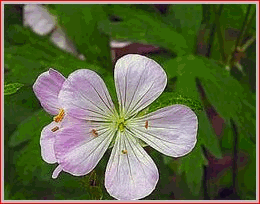
GERANIUM. N. F. GERANIUM Geran. [Cranesbill] GERANIUM
� CRANESBILL N.F.
GERANIUM
� CRANESBILL N.F.
United States Dispensatory 1926.
Compiled by Ivor Hughes
Spotted or Wild Cranesbill, Storksbill; Alum Root; Racine de Bec-de-Grue tachet�, Racine de Pied-de-Corneille, Fr; Fleckstorchschnabelwurzel, G.
This indigenous herb differs from the other native species of geranium in having a perennial root stock and also in that its flowers are much larger, being from 1 to 1� inches in diameter. The petals, which are five in number, are of a rose-purplish color and bearded at their base; the leaves are deeply five parted, the wedge-shaped lobes being irregularly notched. The fruit is a five-celled regma, the persistent 5-cleft style forming a beak-like appendage, whence the popular name of cranesbill. The plant is found throughout the United States in moist woods, thickets, and hedges, and generally in low grounds. It flowers from May to July. The rhizome should be collected in autumn. The commercial supplies of Geranium come mostly from Virginia, North Carolina, Indiana and Michigan.
Description and Physical Properties. � Unground Geranium.� Rhizome cylindraceous, somewhat branched, bent, flattened and strongly tuberculated, from 2.5 to 10 cm. long and from 3 to 15 mm. in diameter; surface marked with root scars and remnant of slender roots, longitudinally wrinkled; externally dark purple-brown; internally light purple-brown; fracture short, non-fibrous, the section shows a thin bark, a distinct cambium, irregular in outline, large central pith, wood indistinct, the fibro vascular bundles few and at unequal distances. Odorless; taste strongly astringent.
Structure. � A more or less irregular cork layer consisting of about 10 rows of tangentially elongated cells, the outer layers with brownish walls and a brownish amorphous content, the inner layers with colorless walls; a layer of about 5 rows of tangentially elongated oval cells; a wide layer of nearly isodiametric parenchyma containing either starch, rosettes of calcium oxalate, or tannin; distinct groups of sieve separated from the central cylinder by a broad, continuous zone of cambium; fibro vascular bundles few, radially arranged with tracheae and tracheids and narrow medullary rays; very large pith, the cells containing starch or in a few instances rosettes of calcium oxalate.
Powdered Geranium. � Purplish brown; fragments composed of cortical or pith parenchyma containing numerous, smooth, simple, ovate or ellipsoidal starch grains up to 0.035 mm. in length, with the hilum near the larger end, the inner lamellae concentric about it, the outer excentric, rosettes of calcium oxalate up to 0.120 mm. in diameter, occasionally up to 0.145 mm. either isolated or contained within the parenchyma; fragment composed of cork cells having brownish walls and a brownish amorphous content; numerous fragments colored bluish black by ammonio-ferric alum T.S.; tracheae small with spiral or reticulate markings; tracheids with reticulate markings or simple pores; with the exception of the tracheae and tracheids, lignified tissue is wanting. N F.
The medicinal properties of geranium are due solely to the tannic and gallic acids it contains. Henry Trimble and J. C. Peacock (A. J. P., 1891, p. 265) collected the plant at periods of the year ranging from January to October, and determined the percentage of tannin as calculated for the perfectly dry drug to vary from 9.72 to 27.85 per cent. They also determined that it belonged to the class of tannins analogous to gallo-tannic acid, yielding pyrogallol on heating. They decomposed the tannin by the action of hydrochloric acid, obtaining gallic acid, glucose, and geranium red as products.
Uses. � Geranium is one of our best indigenous astringents, and may be employed for all the purposes to which these medicines are applicable. The absence of unpleasant taste and of other offensive qualities renders it peculiarly serviceable in the case of infants and of persons of very delicate stomach. Diarrhea, chronic dysentery, cholera infantum in the later stages, and the various hemorrhages, are the forms of disease in which it is most commonly used and with greatest advantage. As an application to indolent ulcers, an injection in gleet and leucorrhea, and a gargle in relaxation of the uvula and aphthous ulcerations of the throat, it answers the same purpose as Kino, Catechu, and other medicines of the same class. It is a popular domestic remedy in various parts of the United States, and is said to have been employed by the Indians.
Dose,
fifteen to thirty grains (1-2 Gm.).Off. Prep. � Fluidextractum Geranii, N. F.
For further information use the site search box at the top right hand of the page or peruse the site library.
![]()